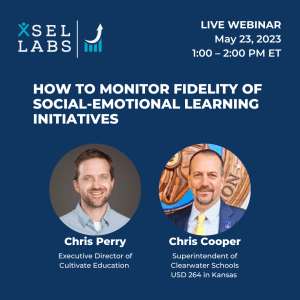Forgive me for being master of the obvious here, but SEL assessment data alone won’t change the world. But they can help. These two blog posts (starting with Making Sense of your SEL Assessment Data) are designed to help educators bridge the gap between collecting good SEL assessment data and taking action to support student growth.
Clearing that gap requires good answers to the questions, “So what?” and “Now what?” The first (“So what?”) is shorthand for, “What do the assessment data tell us about our students?” We discussed how to answer that question in Part 1. The second (“Now what?”) is shorthand for, “Now that we understand something about our students’ SEL, what do we do with what we have learned? What changes can we make to how we work with students that will build on their social and e?.motional strengths and address their social and emotional needs”
For Part 2 in this series, here’s the situation: You’ve Assessed Student SEL. You’ve worked to understand the meaning of the data, answering the question, “So what?”
Developing SEL Skill Development Goals
In the team meeting or meetings that you convened, after you’ve answered the question, “So what?” you are in an ideal position to start figuring out what to do based on what you learned.
Your work to discuss the meaning of your SEL assessment data will lend itself first to identifying a manageable number of measurable student skill development goals. If you noticed that student social problem-solving skills are all over the map, you might set a goal that the percentage of students with problem-solving skills in the average range will increase from X to Y. Or you if student self-control is a challenge area, you might set a goal of an increase in average performance on self-control measures of Z points.
Once the skill development goals are clear, you can set about the task of deciding what you can do to achieve those goals, which is really the heart of the matter when answering, “Now what?”
Reinforce Existing SEL Practice
In my view, there are two kinds of actions you can contemplate. The first is to look in the mirror—identify actions you are already taking that are likely to help get you to the goal. These are actions that members of your team are doing that are not being implemented widely, systematically, or intensively and that, if everyone started doing these things, this would be highly likely to support your students’ skill development. Perhaps, for example, a teacher has identified a highly effective and feasible way to form strong connections with hard-to-reach students, or to scaffold conflict resolution, or to take others’ perspectives. How are they doing that? How could it be done better?
Spend time discussing these possibilities, because the easiest thing to do is what’s right in front of you. Beware the conclusion, however, that “We’re already doing that.” What you want is for people to commit to stretching themselves. Even if they’re already engaging in these practices, push to do it better and more often.
In addition to collective professional wisdom that already exists, if you have assessed student SEL, it is likely that you already use, or at least have purchased, an evidence-based social and emotional program. Those programs contain lessons, activities, and materials focused on developing important social-emotional skills. Consider adopting or adapting adapt the curriculum to address your high priority skill development goals.
Explore New SEL Solutions
After taking stock of existing resources, including professional wisdom and program investments, look outward. There are in fact a large number of social and emotional learning programs available designed to address the kinds of social emotional skill development goals you are likely to develop.
First are the kinds of evidence-based SEL programs described in CASEL’s program guides for elementary and middle and high school. Second are teacher coaching to help teachers develop strong relationships and a positive classroom environment conducive to social-emotional skill development. Third are supplementary materials—a growing number of interactive training technologies or serious games, instructional videos, and other resources that may be deployed rather easily to address specific needs. In reviewing options, consider the strength of the evidence that, when implemented well, the program will have a positive impact.
Now that you’ve taken stock of the options, choose the resources, both internal and external, that you think will give you the best chance of achieving your skill development goals. Put the resources in place. And act. Now, my friend, you’ve answered the question, “Now what?”



